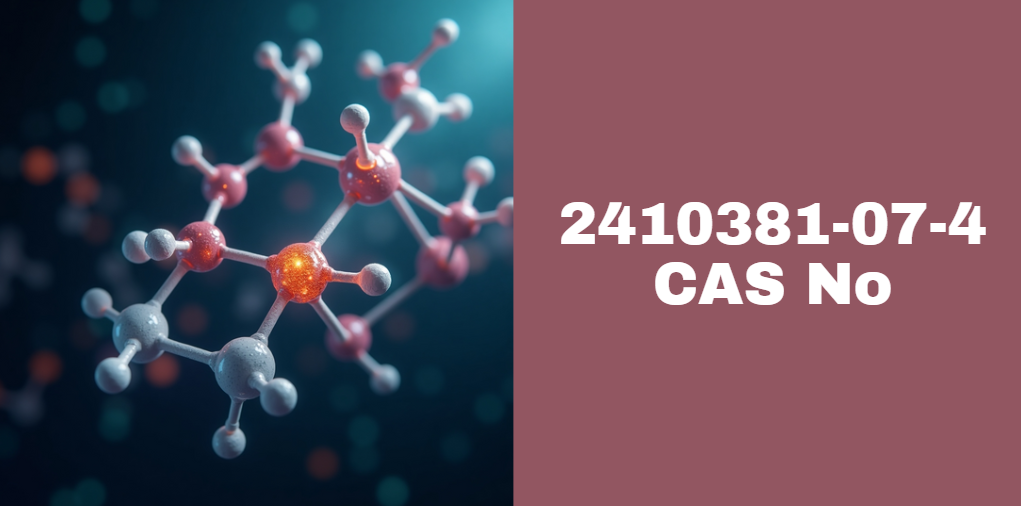Comprehensive Guide to 2410381-07-4 CAS No: Chemical Properties, Applications and Safety
The CAS Number (Chemical Abstracts Service Number) is a unique identifier assigned to chemical substances. The number 2410381-07-4 CAS No corresponds to a specific compound, allowing researchers, industries, and regulatory bodies to track, catalog, and assess it with precision.
CAS Numbers are globally recognized and used to avoid confusion about chemical identities in scientific and commercial settings. These numbers are critical for distinguishing between compounds that may have similar names or properties but are chemically distinct.
The 2410381-07-4 CAS No plays an important role in various industries, particularly in chemical synthesis, pharmaceuticals, and research applications. This compound is significant due to its versatile chemical properties, which make it a valuable intermediate in the creation of other chemicals. Understanding its structure and reactivity is crucial for both its industrial usage and its safe handling.
Chemical Identity and Structure
Molecular Formula & Weight
The molecular formula of the compound associated with 2410381-07-4 CAS No reveals its elemental composition, such as carbon, hydrogen, nitrogen, or oxygen. This formula is essential for understanding the compound’s basic chemical structure and predicting its reactivity.
Additionally, the molecular weight provides insight into the size and mass of the molecules, which is important for determining its behavior during chemical reactions.
Structural Model & Drawings
Chemists often use structural diagrams or representations like SMILES (Simplified Molecular Input Line Entry System) and InChI (International Chemical Identifier) strings to illustrate the chemical structure of a compound. These structural notations reveal the arrangement of atoms and bonds within the molecule, which is vital for understanding how the substance interacts with other compounds.
For 2410381-07-4 CAS No, the exact structure and bond types can be researched using chemical databases, enabling scientists to visualize how the compound fits into larger chemical processes.
Key Functional Groups
This compound contains specific functional groups that define its chemical behavior. These functional groups are responsible for the compound’s reactivity and solubility, impacting its application in various processes.
For example, if the compound contains an amide or cyano group, it would exhibit properties like stability under specific conditions or the ability to react with certain reagents.
Physical & Chemical Properties
Appearance, Color and State
The physical appearance of a chemical compound can provide useful information about its structure and purity. For 2410381-07-4 CAS No, the compound might appear as a solid, liquid, or gas, depending on its molecular characteristics. Researchers need to know whether the compound is crystalline, amorphous, or in powder form, as this can affect its handling and storage.
Melting/Boiling Points, Density, Solubility
Understanding the melting and boiling points of 2410381-07-4 CAS No is essential for determining its stability at different temperatures and its behavior in various environments. The melting point indicates when the compound changes from a solid to a liquid, while the boiling point provides insight into its volatility.
Density and solubility are also crucial for its application in chemical processes and for ensuring that it can be dissolved in appropriate solvents.
| Property | Value |
|---|---|
| Melting Point | – |
| Boiling Point | – |
| Density | – |
| Solubility | Solvent dependent |
Stability under Heat, Pressure, and Light
Chemical compounds react differently when subjected to heat, pressure, or light. 2410381-07-4 CAS No may be stable under standard conditions but could undergo decomposition or unwanted reactions when exposed to extreme temperatures or ultraviolet light.
Understanding these conditions helps ensure safe usage and minimizes potential hazards during storage or processing.
Reactivity Profile
The reactivity profile of 2410381-07-4 CAS No describes how the compound behaves when it interacts with acids, bases, and various solvents. Knowing whether it is highly reactive or inert allows chemists to plan safe reactions and predict the compound’s role in synthetic processes.
Industrial & Laboratory Applications
Pharmaceutical Intermediates & Drug Synthesis
2410381-07-4 CAS No serves as an intermediate in pharmaceutical manufacturing. It may be involved in the synthesis of active pharmaceutical ingredients (APIs) or as a building block in the creation of complex compounds.
Its ability to participate in various chemical reactions makes it a valuable asset in drug development, especially when synthesizing molecules that have medicinal properties.
Specialty Chemicals – Adhesives, Coatings, Polymers
In addition to its role in pharmaceuticals, 2410381-07-4 CAS No is used in the production of specialty chemicals such as adhesives, coatings, and polymers. These products are crucial in industries such as automotive manufacturing, construction, and packaging.
The compound’s chemical properties enable it to contribute to the creation of durable, high-performance materials.
Safety, Handling & Storage
Hazard Identification – Toxicity, Irritancy
As with many chemicals, 2410381-07-4 CAS No may present health hazards if not handled properly. It could be toxic if ingested, inhaled, or absorbed through the skin, depending on its molecular structure. Proper labeling, handling protocols, and safety measures are essential to minimize exposure.
Recommended PPE – Gloves, Goggles, Fume Hoods
To ensure safety, workers should wear the appropriate personal protective equipment (PPE) when working with 2410381-07-4 CAS No. This includes gloves to protect the hands, goggles to shield the eyes, and fume hoods to prevent inhalation of vapors or particles. Such precautions are vital in laboratory and industrial environments.
Storage Conditions & Incompatibilities
The storage conditions for 2410381-07-4 CAS No depend on its physical properties and chemical stability. It should be stored in a cool, dry place, away from incompatible materials such as strong acids or bases. Proper containment is also important to prevent spills or leaks.
First-Aid & Spill Response Procedures
In the event of exposure, immediate action is required. First-aid measures for 2410381-07-4 CAS No typically involve flushing the affected area with water and seeking medical attention. In case of spills, the compound should be contained, and emergency response teams should be contacted.
Environmental Considerations
Biodegradability & Breakdown Pathways
Understanding the biodegradability of 2410381-07-4 CAS No is important for assessing its environmental impact. The compound may undergo breakdown in the environment, but the speed and products of its degradation depend on its chemical structure. Research into the compound’s breakdown pathways helps predict its long-term effects.
Ecotoxicity – Aquatic Effects, Soil Impact
The ecotoxicity of 2410381-07-4 CAS No indicates its potential to harm aquatic life or soil microorganisms if released into the environment. It is crucial to adhere to regulations governing chemical discharge and to treat the compound carefully to prevent contamination of natural ecosystems.
Regulatory Oversight – SDS, GHS Symbols
To ensure safe handling and environmental protection, 2410381-07-4 CAS No is subject to regulatory oversight. Safety Data Sheets (SDS) and Global Harmonized System (GHS) symbols provide essential information regarding hazards, safe usage, and disposal methods.
Regulatory & Compliance Information
CAS Registry Context – Substance Indexing
CAS Numbers, including 2410381-07-4 CAS No, are indexed in global chemical registries and databases. These listings facilitate the tracking, research, and regulatory compliance of chemicals. CAS registry numbers also play an important role in chemical safety regulations.
Labeling & Transport Standards
The proper labeling and transportation of chemicals like 2410381-07-4 CAS No are governed by standards such as the UN Recommendations on the Transport of Dangerous Goods. Compliance with these standards ensures that the compound is safely handled during shipping and storage.
International & Local Regulations
Governments around the world regulate the use and disposal of chemicals like 2410381-07-4 CAS No. These regulations include environmental protection laws, workplace safety standards, and chemical registration requirements that manufacturers and users must follow.
Supply, Purity & Sourcing
Availability from Suppliers & Manufacturers
Chemicals like 2410381-07-4 CAS No are sourced from specialized suppliers and manufacturers. Researchers, pharmaceutical companies, and industrial users often rely on established vendors to obtain high-quality samples of the compound. Availability may vary based on demand and supply chain factors.
Purity Grades, Certificates of Analysis
Purity is critical when sourcing 2410381-07-4 CAS No for research or industrial purposes. Suppliers typically offer the compound in different purity grades, each accompanied by a certificate of analysis to ensure quality control.
Price Range, Packaging Sizes, Lead Times
The price of 2410381-07-4 CAS No can vary depending on factors such as purity, packaging, and order quantity. Researchers should consider these factors when budgeting for purchases. Lead times also vary, so it’s essential to plan ahead for procurement.
Related Compounds & Derivatives
Chemical Analogues & Alternatives
2410381-07-4 CAS No may have chemical analogues and derivatives that serve similar functions in various applications. These compounds offer researchers alternative options for synthesis and experimentation.
Comparative Uses & Benefits
Comparing 2410381-07-4 CAS No with its analogues allows researchers and manufacturers to choose the most effective compound for their needs. This section highlights the comparative advantages and potential drawbacks of using similar substances.
Future Directions
Emerging Research – Nanotech, Green Synthesis
Emerging research areas like nanotechnology and green chemistry are likely to influence the use and development of 2410381-07-4 CAS No. Researchers are exploring more sustainable methods of synthesis and applications in cutting-edge technologies.
Potential New Markets & Innovations
As new industries and applications emerge, the demand for 2410381-07-4 CAS No could increase. Innovation in fields such as renewable energy and advanced materials may lead to new opportunities for this compound.
Conclusion
2410381-07-4 CAS No is a valuable chemical compound in various industries. Its properties make it suitable for pharmaceuticals, research, and specialty chemicals. However, its handling requires careful adherence to safety protocols.
This compound plays a significant role in chemical synthesis and industrial processes. Its use as an intermediate and in other chemical applications showcases its versatility.
When working with 2410381-07-4 CAS No, safety, regulatory compliance, and proper storage are paramount. Researchers and industries should stay informed of best practices and future developments related to this compound.
Recommended Articles
NetworkFinds How HHC Vaping Affects Creativity and Focus: A Comprehensive Guide
Planta Fluidos de Perforación en Punata Camacho Edo. Zulia: A Comprehensive Insight
Kwal Paint 961-240: The Ultimate Guide to a Superior Paint Finish






